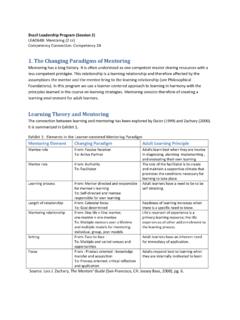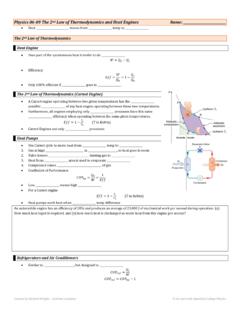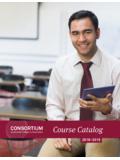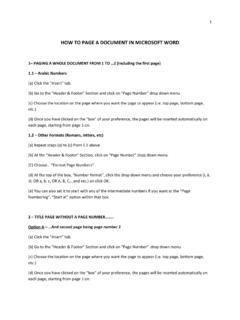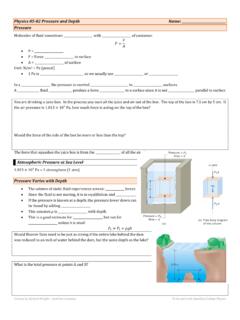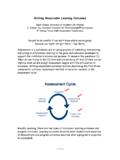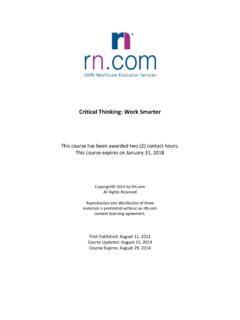Transcription of The Effective Mathematics Classroom - Andrews
1 1 Algebra Readiness, Cycle 1 The Effective Mathematics Classroom The Effective Mathematics Classroom What does the research say about teaching and learning Mathematics ? x Structure teaching of mathematical concepts and skills around problems to be solved (Checkly, 1997; Wood & Sellars, 1996; Wood & Sellars, 1997) x Encourage students to work cooperatively with others (Johnson & Johnson, 1975; Davidson, 1990) x Use group problem-solving to stimulate students to apply their mathematical thinking skills (Artzt & Armour-Thomas, 1992) x Students interaction in ways that both support and challenge one another s strategic thinking (Artzt, Armour-Thomas, & Curcio, 2008) x Activities structured in ways allowing students to explore, explain, extend, and evaluate their progress (National Research Council, 1999).
2 X There are three critical components to Effective Mathematics instruction (Shellard & Moyer, 2002): 1. Teaching for conceptual understanding 2. Developing children s procedural literacy 3. Promoting strategic competence through meaningful problem-solving investigations x Students in the middle grades are experiencing important crossroads in their mathematical education. They are forming conclusions about their mathematical abilities, interest, and motivation that will influence how they approach Mathematics in later years (Protheroe, 2007, p. 52). x Instruction at the middle grades should build on students emerging capabilities for increasingly abstract reasoning , including: 9 thinking hypothetically 9 Comprehending cause and effect 9 reasoning in both concrete and abstract terms (Protheroe, 2007) Classroom Observations Classroom observations are most Effective when following a clinical supervision approach (Cogan, 1973; Holland, 1998).
3 During a Classroom observation cycle, the Classroom observer and the teacher meet for a preconference, during which the terms of the Classroom observation are established. A focusing question is selected, and the Classroom observer negotiates entry into the teacher s Classroom . Focusing questions provide a focus for Classroom observation and data collection, and could emerge from big idea questions such as: 2 Algebra Readiness, Cycle 1 The Effective Mathematics Classroom What instructional strategy are you looking to expand? What are the expected outcomes of the Classroom observation? During the observation, data is collected by the Classroom observer while the teacher teaches the lesson.
4 The observer collects data regarding only the focusing question that was agreed upon during the preconference. The tool for data collection must match the purpose of the observation. After the observation, the Classroom observer and teacher meet for a postconference. During that time, the teacher looks at the data that is collected, and the observer asks the teacher what he/she notices from the data. Based on the teacher s responses, a conversation focusing on the questions addressed during the preconference. It is entirely possible (and, indeed, likely) that the focusing question is not answered, but the postconference conversation results in an additional list of questions that can guide continuing Classroom observations and post-observation discussions.
5 Classroom observations: What should the teacher be doing? In an Effective Mathematics Classroom , an observer should find that the teacher is (Protheroe, 2007): x Demonstrating acceptance of students divergent ideas. The teacher challenges students to think deeply about the problems they are solving, reaching beyond the solutions and algorithms required to solve the problem. This ensures that students are explaining both how they found their solution and why they chose a particular method of solution. x Influencing learning by posing challenging and interesting questions. The teacher poses questions that not only stimulate students innate curiosity, but also encourages them to investigate further.
6 X Projecting a positive attitude about Mathematics and about students ability to do Mathematics . The teacher constantly builds students sense of efficacy and instills in her students a belief that not only is the goal of doing Mathematics attainable, but also they are personally capable of reaching that goal. Mathematics is not presented as something magical or mysterious. Classroom observations: What should the students be doing? In an Effective Mathematics Classroom , an observer should find that students are (Protheroe, 2007): x Actively engaged in doing Mathematics . Students should be metaphorically rolling up their sleeves and doing Mathematics themselves, not watching others do the Mathematics for them or in front of them.
7 X Solving challenging problems. Students should be investigating meaningful real-world problems whenever possible. Mathematics is not a stagnant field of textbook problems; rather, it is a dynamic way of constructing meaning about the world around us, generating new knowledge and understanding about the real world every day. 3 Algebra Readiness, Cycle 1 The Effective Mathematics Classroom x Making interdisciplinary connections. Mathematics is not a field that exists in isolation. Students learn best when they connect Mathematics to other disciplines, including art, architecture, science, health, and literature. Using literature as a springboard for mathematical investigation is a useful tool that teachers can use to introduce problem solving situations that could have messy results.
8 Such connections help students develop an understanding of the academic vocabulary required to do Mathematics and connect the language of mathematical ideas with numerical representations. x Sharing mathematical ideas. It is essential that students have the opportunity to discuss Mathematics with one another, refining and critiquing each other s ideas and understandings. Communication can occur through paired work, small group work, or class presentations. x Using multiple representations to communicate mathematical ideas. Students should have multiple opportunities to use a variety of representations to communicate their mathematical ideas, including drawing a picture, writing in a journal, or engaging in meaningful whole-class discussions.
9 X Using manipulatives and other tools. Students, at the middle grades in particular, are just beginning to develop their sense of abstract reasoning . Concrete models, such as manipulatives, can provide students with a way to bridge from the concrete understandings of Mathematics that they bring from elementary school to the abstract understandings that will be required of them as they study algebra in high school. Teachers teach their students how to use manipulatives, and support the use of manipulatives to solve meaningful problems that are aligned with the lesson s objectives. Classroom observations: What kinds of questions to ask? Teachers should ask questions that promote higher-level thinking .
10 That does not mean that a teacher should not be asking questions at the lower end of Bloom s Taxonomy of cognitive rigor. In fact, it is important that a teacher begins a lesson with questions at the Recall and Understand levels of Bloom s Taxonomy. However, in order to solve meaningful problems, students must be challenged with higher-level questions that follow the lower-level questions. Students will find difficulty applying their mathematical ideas or analyzing a mathematical situation if they are not asked higher-level questions in Classroom activities and discussions. 4 Algebra Readiness, Cycle 1 The Effective Mathematics Classroom What are some best practices for Mathematics instruction?

